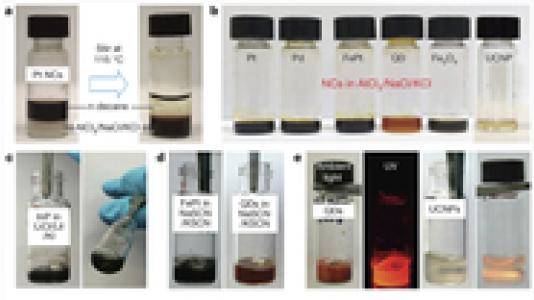
A team of researchers, led by scientists at the University of Chicago and the U.S. Department of Energy’s (DOE) Argonne National Laboratory, has identified a new class of colloidal systems involving inorganic solvents, a discovery that could offer new applications for nanotechnology and better functional materials.
Colloidal systems are a mixture in which one substance is uniformly distributed throughout the second; although the naked eye cannot see the individual particles in a colloid, these particles, especially nano-size crystals can be identified with certain powerful microscopes. (In contrast, a true solution, like plain sugar dissolved in water, is one in which one substance is completely dissolved in the other.)
In a research report published in the journal Nature, the team showed that nanoparticles form stable colloids in various molten inorganic salts, but the stability of these colloids cannot be explained by traditional mechanisms.
Instead, theoretical analysis and modeling suggest that a layer of surface-bound solvent ions causes the partial ordering of molten salts around each nanoparticle, preventing the aggregation of the systems. The unique properties of colloidal systems show promise for new applications across industries.
Lead researcher Dmitri Talapin, who has a joint appointment as professor of chemistry at University of Chicago and at Argonne, said the results suggest that a layer of surface-bound solvent ions produces long-ranged charge-density oscillations in the molten salt around solute particles.
“This is occurring in a greater range of inorganic particles, which offers the opportunity to introduce colloidal techniques to solid-state science and engineering applications,” he said.
Byeongdu Lee, an Argonne physicist in the X-ray Sciences Division, said the study advances the understanding of colloids in unconventional solvents.
“Cow’s milk is one of the best-known colloids, as it is liquid butterfat that is dispersed in water. This new study showed you can make colloids using molten inorganic salts, such as molten sodium chloride, as solvents,” he said.
The team used the Advanced Photon Source (APS) and Center for Nanoscale Materials at Argonne, both DOE Office of Science User Facilities, to conduct the experiments. Small angle X-ray scattering technique, taking advantage of high penetration power of high-energy X-rays from the APS, was crucial to see the colloidal nanomaterials embedded in the high-density medium.
Colloids in molten salts offer multiple opportunities for making better functional materials. In the follow-up report, by the same team as well as researchers from Argonne’s Center for Nanoscale Materials, it is reported that colloids in molten salts have been used to prepare colloidal gallium arsenide quantum dots. The molten salts allowed efficient annealing of gallium vacancies, or defects, in gallium arsenide nanocrystals.
The team is now working on further advancing these unconventional colloidal systems and understanding the principles behind their formation and stability.
Results from the first study, “Stable colloids in molten inorganic salts,” were published in Nature; the second study, “Understanding and Curing Structural Defects in Colloidal GaAs Nanocrystals,” was published in Nano Letters. Funding was provided by the National Science Foundation, Air Force Office of Scientific Research, Department of Defense Office of Naval Research and the II-VI Foundation.
Argonne National Laboratory seeks solutions to pressing national problems in science and technology. The nation’s first national laboratory, Argonne conducts leading-edge basic and applied scientific research in virtually every scientific discipline. Argonne researchers work closely with researchers from hundreds of companies, universities, and federal, state and municipal agencies to help them solve their specific problems, advance America’s scientific leadership and prepare the nation for a better future. With employees from more than 60 nations, Argonne is managed by UChicago Argonne, LLC for the U.S. Department of Energy’s Office of Science.
The U.S. Department of Energy’s Office of Science is the single largest supporter of basic research in the physical sciences in the United States and is working to address some of the most pressing challenges of our time. For more information, visit the Office of Science website.